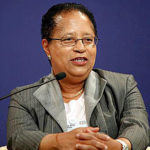By ROSE L. THAYER and ERINN CALLAHAN
Killeen Daily Herald
FORT HOOD, Texas (AP) _ Col. Patricia Darnauer never noticed she was the only female brigade-level commander at Fort Hood until all 18 leaders came together.
“It’s not at the forefront,” said the commander of Carl R. Darnall Army Medical Center.
In her 28-year career, Darnauer said she’s gone from not seeing very many female leaders in her chain of command to now having “two strong women who’ve done great things.”
“I’m proud of the growth the Army’s made,” she told the Killeen Daily Herald (http://bit.ly/1q42KGl).
Most importantly, she said, women taking over leadership roles got there because they are competent, not because the Army thought it was time for a woman to take the job.
“They are judged on their competence and they’ve demonstrated in whatever they’ve done previously the success they’ve had and are able to do more,” she said. “We shouldn’t be surprised they can do it. They were trained to.”
About 1,115 female officers serve at Fort Hood along with 2,439 noncommissioned officers, according to information provided by Fort Hood. Many of those women are moving into leadership roles that break down gender boundaries. The 1st Cavalry Division Horse Cavalry Detachment welcomed its first female commander, Capt. Elizabeth Rascon, in June.
“I’m not focused on being the first female commander, I’m focused on how to be a commander,” Rascon told the Herald upon joining the company-size unit. “When I get in front of troopers, I don’t want them to see me as a little woman on a horse, but as a commander.”
Maj. Agnita Williams, 33, also served as a “first female,” and agreed the focus should be on professionalism, not gender. She led a forward support company at Fort Carson, Colo.
“Leadership ability always outshines the fact that you’re the first,” said the current support operations officer for 1st Brigade Combat Team, 1st Cavalry Division. “It’s not necessarily about physical ability, and it’s not about having to have the first female to do the job. If I wasn’t qualified, if my report didn’t state potential, I wouldn’t be put in this position.”
Williams has nearly 12 years in the Army and she said she loves her job as a logistician. If she were joining now, at a time when more combat positions are open to women, she said she would still choose logistics.
“You can’t shoot, move or communicate unless I bring that stuff to you,” she said. “It’s exciting to see different branches in the Army open to women. It shows females in the military can do anything they put their minds or bodies to.”
Capt. Candra Maita also watched change happen since she enlisted in the Air Force in 1993, and even since becoming a commissioned intelligence officer in the Army in 2007.
“The military is transforming itself into a stronger, more powerful force, and that includes more females,” said Maita, commander for Headquarters Support Company, Headquarters and Headquarters Battalion, 1st Cavalry Division. “That’s also the way our society is now. This generation coming up is more accepting _ period.”
Last month, Fort Hood’s 36th Engineer Brigade participated in the Soldier 2020: Gender Integration Study, to help create standards to open combat jobs to women. Occupations still closed to women include combat engineer, armor, infantry and field artillery.
“Nowadays, women really have to think about what they’re signing up for,” Maita said. “If you want to join the military and serve your nation, you very well could be in a combat zone.”
Overall, Maita said the military has progressed by “leaps and bounds” regarding gender equality. “Fighting for your country shouldn’t be gender related. Change takes time, and we’re still in the throes of making it happen, but there are more opportunities (for women) now than there ever have been.”
Darnauer said she’s too old now to forge a new path, but is happy to see the opportunities available. She wonders if she would have reached for such a goal as a young lieutenant.
“I liked to prove people wrong,” she said with a laugh.
Darnauer began her Army career as a commissioned second lieutenant from Cornell University’s ROTC program in 1986. She joined the Medical Service Corps, where she said she appreciated the opportunity it provided to work in both a hospital setting and a line unit. As a junior officer, Darnauer earned the Expert Field Medical Badge, the Parachutist Badge and the Air Assault Badge.
At that time, she said she wasn’t trying to prove a woman could earn those badges, but rather earn the respect of her peers in an infantry unit.
“The thing that set me apart wasn’t my gender,” she said. “The discriminatory (factor) was air assault school.”
With so few women to look toward in her early career, Darnauer said she strives to be a role model today.
“I’m proud of the growth that the Army’s made,” she said. “Don’t constrain your dreams or aspirations based on gender. It’s not an Army of that; it’s not a society of that. You need to go for it.”
___
Information from: Killeen Daily Herald, http://www.kdhnews.com










